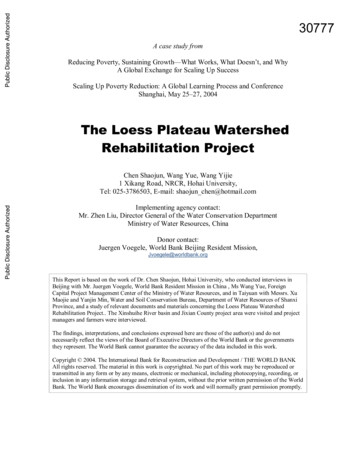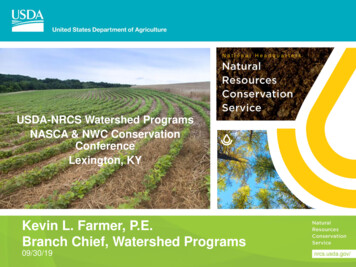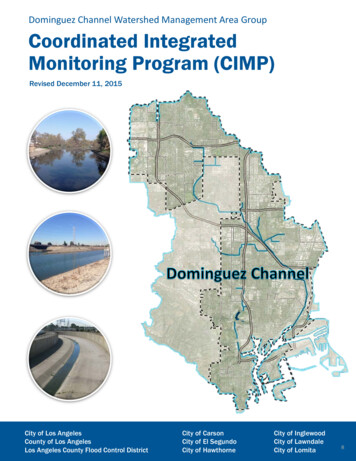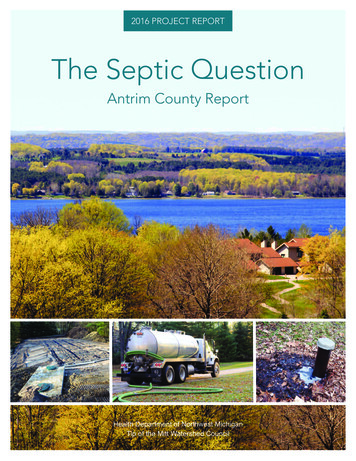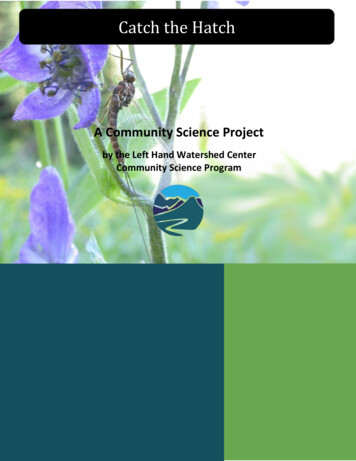
Transcription
Catch the HatchA Community Science Projectby the Left Hand Watershed CenterCommunity Science Program
this page intentionally left blank
Catch the HatchA Community Science ProjectVolunteer Training ManualBy:Left Hand Watershed CenterCommunity Science Program6800 Nimbus RoadLongmont CO 80503 June 2020 Suggested Citation:Hummel, D., Sorokin, Y, Olson, J., Newman, S., Scarpino, R., and Newman, G. 2020.Catch the Hatch: A Community Science Project. Volunteer Training ManualLeft Hand Watershed Center, Longmont, Colorado 80503. 26 pages.1
this page intentionally left blank 2
Table of ContentsPROJECT OVERVIEW5What Is Expected of Me?5What Can I expect as a Volunteer from the Catch the Hatch Team5Project Timeline6RELEVANCE TO SCIENCE6Mayflies and Pale Morning Duns7Research Questions7PROJECT LOGISTICS8Sign Ups8Gear List9Observation Day Overview9Catch the Hatch Protocol10Datasheet13Technology and Data Entry13Website Registration on CitSci.org14Data Entry Instructions for the Website17Data Entry Instructions for My Watershed app223
this page intentionally left blank 4
PROJECT OVERVIEWThe Catch the Hatch community science project will track mayfly emergence in Boulder, Left Hand, NorthSt. Vrain, and St Vrain Creeks to help inform watershed health. As you know, mayflies are sensitive topollution and changing climate. Many scientific organizations sample aquatic insects in streams to informwater resource and land managers on changes in water quality throughout the region. However, so far ithas been difficult to track the emergence and adult phase of these insects. It is important for us to capturethese life phases as the emergence of mayflies is a critical life stage for reproduction and as a food sourcefor fish.Thank you for joining us this summer while fishing, recreating and enjoying your watershed as a Catch theHatch volunteer! Your participation helps inform science! We will provide you with nets and samplingtools to capture and identify emerging mayflies. This year we will be tracking the emergence of the PaleMorning Dun, a mayfly species well known and loved by anglers and fish alike.What Is Expected of Me?As a volunteer contributor, you are expected to honor your time commitment and follow data collectionand input protocols throughout the project, as well as have all data entered and return gear and samplesupon project completion. Throughout the project, your time commitment includes signing up for one ormore observation days at sampling locations, visiting the sampling location on those days, and makingobservations for a minimum of 30 minutes while you recreate on the creek. Data collection expectationsinclude having the appropriate project-provided gear to successfully capture, identify, and collect mayflyobservations. Data input expectations include filling out and storing a hard copy datasheet and enteringdata online on the citsci.org website or using the My Watershed mobile application.Upon completion of the project, you are expected to return project-provided gear and all stored mayflysamples (labeled and stored in project-provided vials) to the Catch the Hatch team. You will be notified ofgear and sample return options by the end of the project.What Can I expect as a Volunteer from the Catch the Hatch TeamAs a volunteer contributor, you can expect updates and information from the Catch the Hatch teamthroughout the project, as well as updates on how we use your data after project completion (analysisand reporting). Your data will be used to address our annual research questions and contribute to multiyear research questions and long-term data sets. This year’s annual research questions will assess theaccuracy of volunteer sub adult and adult Pale Morning Dun identification and the frequency and timingof sub adult and/or adult Pale Morning Dun observations during their peak emergence at three differentcreek locations. Our multi-year research questions compare presence of nymph and adult stages at thesecreek locations and assess changes in observations during peak emergence in relationship to creektemperature over time. Your data will also help develop and contribute to the National Phenology5
Network’s mayfly phenology database, which is a collaborative effort to monitor impacts of climatechange in the United States.Project TimelineThe Catch the Hatch 2020 project will run from June 15 through July 15. Collectively, volunteercontributors will visit each site once a day throughout this project period to record site conditions andobserve for sub adult or adult Pale Morning Duns. After July 15, all project materials and gear will becollected and data will be analyzed and reported.RELEVANCE TO SCIENCEThe life cycle of aquatic insects is complex and spans multiple environments. Throughout the life cycle,aquatic insects occupy both aquatic and terrestrial habitats, and therefore, are sensitive to conditions inboth of these environments. However, our scientific understanding of these organisms is heavily focusedon aquatic life stages. The instream dwelling larval phase can last for years, while the adult terrestrialphase lasts for a matter of hours to days. Because there are fewer environmental variables for the aquaticlarval phase, larval communities are commonly collected and analyzed as indicators of water qualityconditions. However, far less is known about the distribution and phenology of adult stages. Tracking theemergence and flight of adult stages is not only critical for understanding population dispersal andreproduction, but also for understanding their sensitivity to changes in watershed conditions and ongoingclimate change.In our Front Range creeks, flowspeeds and creek temperature aredriven by annual snowpack and melt,which in turn, influence theemergence patterns of aquaticinsects. However, these watershedconditions are expected to change asa result of climate change. Our effortto track emergence patterns ofsensitive species in relationship tochanging flows and temperature overtime will be an important indicator ofwatershed health and ecosystemfunction, and their sensitivity toclimate changes.6
Mayflies and Pale Morning DunsMayflies are among the most sensitive groups to water quality and hydrologic conditions. Studies haveshown that their emergence is correlated to the higher creek temperatures that follow peak flows inspring/early summer. The Pale Morning Dun (PMD) is well-known and easily identifiable species of mayflythat is found in the transition zone of the Front Range. Coupled with the fact that it has a short windowof peak emergence compared to others mayfly species, PMDs are expected to be a strong indicator ofwatershed conditions for our observation sites.Research QuestionsRQ1. Can trained community volunteers accurately identify sub adult and/or adult Pale Morning Duns(Ephemerella dorothea infrequens) during their peak emergence from June 15 through July 15?RQ2. What sampling time frame resulted in more correct observations of sub adult and/or adult PaleMorning Duns?RQ3. Are Pale Morning Dun adult and nymph life stages present in the same location from year to year?RQ4. How does presence of sub adults and adult Pale Morning Duns during peak emergence changeover time in the transition watershed zone of Boulder, Left Hand, and North St. Vrain Creeks?7
PROJECT LOGISTICSAs a volunteer for Catch the Hatch, you will use the following protocol and project-provided gear to collectobservational data and store any samples needed. Here, we provide specific instructions for how to makeobservations, collect samples, and input data using a datasheet and the citsci.org Catch the Hatch projectdata portal and/or the My Watershed mobile app. Throughout the project, you will be able to makeobservations and track all project observations live!(see: ect Info.php?ProjectID 2341)Sign UpsUse the project page to sign up for observation days. You are encouraged to sign up for multipleobservations! Simplified instructions on how to sign up for observation days are available on the Catchthe Hatch webpage.(see tch/)As a volunteer, you will choose dates to visit sites on Boulder, Left Hand and North St. Vrain, and St VrainCreeks. If possible, we request that volunteers commit to more than one observation day from June 15through July 15 to help cover all possible days for each month. Volunteers should give sign up priority todays with no sign ups, however, multiple sign ups per day is fine. Collectively, our goal is to have onevolunteer signed up for each day between June 15 and July 15.8
Gear ListThe Catch the Hatch Team will provide you with a Gear Kit and a list of items you need to bring. Pleasekeep track of these items, as they will be returned upon project completion.Gear Kit Contents to bring:1.2.3.4.5.6.Hard Copy Datasheet- found in this packet and providedCatch the Hatch Protocol- found in this packetID Guide- provided3-Piece Collapsible Net- providedPre-filled Sample Vial and Labels- providedThermometer- providedWhat you will need to ptional: My Watershed installed on your mobile phoneObservation Day OverviewThis is a brief summary of an observation day. Please refer to the Catch the Hatch Protocol and Technologyand Data Entry instructions for more detail.1. PreparePlan a time when you can visit a designated project site for at least 30 minutes. During this time, plan tofish, recreate, and enjoy your watershed, while also keeping an eye out for mayfly emergence and recordobservations.2. Choose a Timeframe (or both!)Visit a designated project site for at least 30 minutes between 11am and sundown to record observationsof Pale Morning Dun (PMD) adults or sub adults. If possible, give priority to observations during the Tier1 timeframe. Please remember that observations of “No PMDs Present” are just as important as thosefinding PMDs! Tier 1: 11am to 2pm. During this time, you will be looking for sub adults that have a characteristic“pale” appearance.Tier 2: 2pm to sundown. During this time, you will be looking for sub adult or adult forms. Adultshave a darker appearance with clear wings.An ID guide will be provided to all Data Catchers with images of PMD sub adults, adults, and look-alikes!9
3. Collect DataOn-site data collection will include site information and photo, one water temperature measurement,time-stamped observations of sub-adult and/or adult PMDs (if found), and one captured PMD sample (iffound) that will be stored in a project-provided vial. Data will be recorded on a hard copy paper datasheetand subsequently entered online on the citsci.org Catch the Hatch project website here.(see: yForms/DataEntryForm.php?FormID 2391)Catch the Hatch ProtocolStep 1. Prepare. Prior to an observation, you should complete some important preparation stepslisted below:1. Register for Catch the Hatch project on citsci.org (see instructions under Technology and DataEntry, Registration Instructions below).2. Participate a virtual training event (either with instruction or self-directed)3. Receive a gear kit by coordinating a pickup or delivery with project staff on the Project Page(items listed in Observation Day Overview above)4. Sign up for the creek site and observation date (see instructions under Sign Ups above)5. Optional: download My Watershed app on your mobile phone.Step 2. Choose a Timeframe. During preparation, plan a time when you can visit a designatedproject site for at least 30 minutes. There are two possible time frames between 11am and sundown torecord observations of PMD adults and sub-adults. If possible, give priority to observations during theTier 1 timeframe.Remember that observations of “No PMDs Present” are just as important as those finding PMDs! Tier 1: 11am to 2pm. During this time, you will be looking for sub-adults that have a characteristic“pale” appearance (see ID guide).Sub-adults may be emerging from the creek’s surface, a time when they are metamorphosingfrom larvae (nymph) to sub-adult. They are also vulnerable prey to fish- makes good fishing!You may also find sub-adults flying from creek shoreline, where they will rest and morph into fulladults. Even if you don’t see them actively emerging, be sure to check the shoreline substrate andvegetation for resting sub adults or adults. Tier 2: 2pm to sundown. During this time, you will be looking for sub-adult or adult forms. Adultshave a darker appearance with clear wings.Sub-adults or adults may be found along substrate or vegetation. You may also find adults flyingin the air as they prepare to mate. After mating, females will return to the water’s surface to laytheir eggs. They will be vulnerable to predators one last time!10
Step 3. Navigate to Observation Site. The Catch the Hatch webpage provides coordinates,navigation option, and written out instructions on how to get to each creek location.(see tch/)To review: creeks, site names, coordinates, and simple instructions are listed below:1. Boulder Creek- Memorial Park: 40.005056, -105.337028From Eben G. Fine Park on Boulder Canyon Drive, continue up Boulder Canyon Drive for 3 miles.After driving through tunnel, turn Left onto pull off. Site location includes entire section of creekaccessible from the park pull off. Follow instructions on protocol upon arrival.2. Left Hand Creek- Buckingham Park: 40.111333, -105.307139From US-36 W in Altona, turn Left onto Lefthand Canyon Drive for 2.5 miles. Turn right intoparking area at Buckingham Park. Site location includes entire section of creek both upstreamand downstream of parking lot. Follow instructions on protocol upon arrival.3. North St. Vrain Creek- Button Rock: 40.228889, -105.341278From Lyons, head northwest on US-36 W for 4 miles. Turn Left onto Longmont Dam Road for 3miles. Parking area for Button Rock will be on your left. Site location includes entire section ofcreek accessible from the parking lot. Follow instructions on protocol upon arrival.Step 4. Make an Observation and Record Data.Remember to always use a paper datasheet and store photos on your phone or camera! Then, afterreturning to your computer or cellular connectivity, enter data to the website and/or My WatershedA. Record site information. Upon arrival, record the following site information and data: Recorder (datasheet only)DateSite Name: Boulder Creek- Memorial Park, Boulder Creek- Eben. G. Fine, Left HandCreek- Buckingham Park, North St. Vrain Creek- Button Rock, St. Vrain Creek- Bohn ParkArrival Time: date and timeWeather: clear, hail, wind, rain, overcast, partly cloudyB. Take a site photo. Take a landscape photo that captures both edges of the creek using yourmobile phone. Please take and store all site photos locally to your phone or camera and uploadwith your data on the website or My Watershed app later.C. Take a creek temperature and record. During your site visit, take one water temperaturemeasurement. Submerge and leave you thermometer in slower moving water, or a place it will11
not wash away. Leave the thermometer submerged for 5-10 minutes. Record temperaturereading.D. Observe for PMDs. While you fish, recreate, and enjoy your watershed, look on the water’ssurface, vegetation, and substrate for sub-adult and adult PMD. Remember that depending onthe time of day, you may see sub-adults or adults emerging, resting, or flying. See Step 2.instructions for further details.If you see mayflies or any insect you suspect may be a PMD, please use your aerial net and IDguide to capture and identify.E. Record observations. If you do not observe and/or capture and identify adult or sub-adultPMDs during your site visit, then record ‘No’ for visual observation data next to both adult andsub-adult life stages and ‘No’ for sample storage.If you do observe and/or capture and identify adult or sub-adult PMDs during your site visit, thenrecord ‘Yes’ for visual observation data and the observation time next to the applicable the lifestage, adult or sub-adult. If your PMD was captured and identified, then proceed to Step 5.instructions before you end your observation.We would like a captured sample for all recorded ‘Yes’ observations! Try your best to limit ‘Yes’observations without capturing, identifying, and storing a sample.F. End your observation. After you have finished making observations and enjoying your time onthe creek, record your time of departure. Your departure time is when you leave the creek sitethis can be hours after a PMD observation!Step 5. Sample storage and photo. If you have captured and identified an adult or sub-adultPMD, then take a photo of the sample and carefully transfer it into a project provided vial for storage untilthe end of the project. Multiple samples per vial are welcome! You can take a photo before or after placingit in the vial- or both. The citsci.org website and My Watershed app can upload multiple photos.Using a strip of paper (use post-it note, Rite in the Rain, or card stock; printer paper will degrade) andpencil, label your sample with the site name, date, and time. Place the paper label into your vial and screwyour cap on tightly. Please store your vials in a cool, safe place! They are filled with 80% ethanol solution. Werecommend storing vials in the plastic bag for safe keeping in and out of the field.While making observations, be sure to fill out the datasheet below. Then upload data on the citsci.orgwebsite or the My Watershed app. Additional copies of datasheets will be provided depending on yourobservation needs.12
DatasheetTechnology and Data EntryAs a volunteer for Catch the Hatch you will use multiple forms of technology to collect and enter data sowe can ensure excellent data quality and storage and avoid any accidental data loss. Above all, we ask youuse and store a paper datasheet to enter data of your observations each day (the datasheet is providedin this manual and your packet). You may then transfer your hand-written data directly into the onlinedatasheet on the citsci.org website or the My Watershed app that will upload your observation to ourproject website on citsci.org.Below are: 1. Website registration instructions (must complete before and observation for either dataentry option), 2. data entry instructions using the website after a site visit, and 3. data entry instructionsusing the My Watershed app (with Android screenshots, iOS are similar).13
Website Registration on CitSci.orgStep 1: Before heading out to make observations, create your account on thewebsite, CitSci.org.Navigate to the website https://citsci.org and click on the “Sign Up” button on the home page.Fill out the registration information and click Submit. You will receive an email with a link that you mustclick to validate your email.14
Step 2: Join the “Catch the Hatch” projectOnce you’ve validated your email address and logged in, find the “Catch the Hatch” project by clickingon the “Projects” link in the navigation bar.In the search bar, type in “Catch the Hatch”, then click the “Ask to Join”.15
Fill out the form to request to join the “Catch the Hatch” project as a Contributor. The request will besent to the project manager, and you will receive an email once the manager approves your request.16
Data Entry Instructions for the WebsiteMake sure you have completed steps 1 & 2 from the Website Registration Instructions above beforeentering data with the website.Step 1: Log in to the website, citsci.org, and go to the Catch the Hatch projectpageNavigate to https://citsci.org, and log in. Once logged in, click on the “My Projects” dropdown in the upperright corner of the website and select “Catch the Hatch”. This will take you to the main project page seenbelow.17
Step 3: Access the Catch the Hatch
5. Optional: download My Watershed app on your mobile phone. Step 2. Choose a Timeframe. During preparation, plan a time when you can visit a designated project site for at least 30 minutes. There are two possible time frames between 11am an
